Preventing Seashore Water Accidents Using Advanced Technologies
Toshinori Ishikawa
Professor, Chuo University Research and Development Initiative
Area of Specialization: Coastal Engineering
Special feature for commemorating the 20th anniversary of establishment of Research and Development Initiative, Chuo University
This year, Research and Development Initiative, Chuo University commemorates the 20th anniversary of establishment. Since it was established in July 1999, it has been tackling problems with the actual society, for the purpose of developing a sustainable society, as a research center with the mission to achieve collaboration among industry, government, and academia and deepen exchanges for research. Over the past two decades, more than 100 research units have been organized, and many research outcomes that are influential academically and socially have been produced thanks to the efforts of a lot of participating researchers.
This special feature is focused on researchers participating in ongoing research units, and describes their research activities, to introduce some of research outcomes at Research and Development Initiative.
As soon as I returned from the offshore to the beach with a swimmer, I was contacted via walkie-talkie to go back to offshore. During summer vacations in my school days, compared to the present, the beach was crowded with many people. Because I had better swimming ability than my fellow lifesavers, I was focusing on rescues for the swimmers who were pulled away to the sea and drowning swimmers. There were some precious lives that I could not save. One should never make a fun time a grief at the sea. This is the origin of my research and development.
Current situation of seashore water accidents
At the beaches in Japan, the number of rescue cases by lifesavers including unconscious drowning people is estimated to be 2,000 to 3,000 each season (statistical data of about 200 beaches, by Japan Lifesaving Association). In reality, the number of rescues at a beach is five to seven times the number of swimming accidents that are announced by public rescue agencies. 45 percent of these accidents are due to rip currents (offshore flow), and at some beaches, 100 to 300 of the people who are swept away by rip currents are rescued in one season[1]. There are also many water accidents caused by rip currents in other countries. For example, of the beachfront rescues, the percentages of accidents caused by rip currents are 57.4% in Australia, 53.7% in the United States, 57.9% in the United Kingdom, and 49.4% in New Zealand[2]. Meanwhile, in the case of cardiopulmonary arrest due to drowning, the possibility of saving lives drops sharply after 3 to 4 minutes. In case of lifesaving activities with witnesses by lifesavers at the beach, the one-month survival rate/the reintegration rate among the drowning people is 59.1%[3]. This figure is high compared with the one-month survival rate of people with cardiopulmonary arrest in Japan. Nonetheless, obviously, it is extremely important to prevent drowning accidents at the beaches.
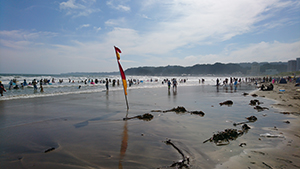
Figure 1. Usage situation (Onjuku Central Beach. August 10, 2018). Many swimmers enjoying on the beach
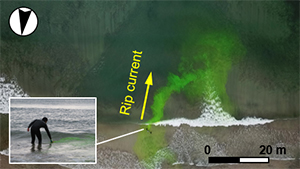
Figure 2. Rip current research using colorant (December 10, 2018). Visualization of rip current, which is the flow from the beach to offshore
Difficulty of risk perception on the beach and visualization of rip current
Seashore accidents are caused by natural factors, such as rip currents and winds, as mentioned above, and by human factors such as lack of swimming ability, fatigue, and drinking[4]. Because natural factors cannot be controlled by humans, risk management on the beach becomes critical to accurately extract hazards, think about the ways to avoid or reduce them, and act accordingly. However, the problem here is the risk perception bias by beach users. It is difficult to extract hazards from temporally and spatially changing natural environments, such as waves, tides and winds. The height of waves and rocky areas can be visually recognized as dangerous, but the water flow like rip currents is hard to understand and recognize. Even if it can be recognized, people tend to underestimate the scale. As a countermeasure, visualization of rip currents and alarming beach users (information provision) may be effective. In fact, a questionnaire survey to investigate the crisis management awareness using digital signage which visualizes rip currents targeting 142 beach users revealed more than 90% of swimmers recognized the rip currents, and that they would try to swim away from the rip current area[5].
Accident prevention and early rescue and life-saving system using AI and IoT
In order to prevent a water accident due to rip currents, beach users need to understand the ever-changing natural environment, recognize rip currents, and avoid the danger. However, as described above, it is difficult to recognize rip currents that are visually incomprehensible. Furthermore, in the current situation where monitoring and rescue activities are being conducted by tens of lifesavers for tens of thousands of beach users, in order not to lead to a serious accident, early detection of swimmers who are being swept away by a rip current and rescuing them is important. In order to address these issues, the authors[*] developed a system in which AI analyzes the image of the sea surface captured with a web camera installed on the coast on a real-time basis, and automatically detects the occurrence of a rip current that changes temporally and spatially and human movement to prevent water accident and facilitate prompt rescue. In this system that utilizes IoT, when a rip current is detected, an alert visualizing the rip current is displayed on the digital signage of the beach on a real-time basis to urge the beach users to take voluntary actions to prevent accidents. It also sends a notification to the smartwatches of lifesavers at the beach. Furthermore, when a person enters a rip current area, a rescue request is sent to lifesavers. The rip current detection function by AI is constructed by the deep learning model using teaching data that indicate the rip current location. The precision of rip current detection (the rate at which rip current was actually occurring to the result of AI's rip current detection) at the time of construction of the AI engine was 91.1%. Furthermore, the authors verified the accuracy of detecting the rip current occurrence by AI when actually operating the developed system on a local beach using the occurrence detection results (image data every 20 minutes when a rip current was detected by AI, 2-3 images/second) by image verification, image analysis with averaging processing, and nearshore current calculation with wave conditions at the time of detection. The verification results showed that the occurrence of rip currents was confirmed on many images, including intermittent rip currents, such as bubbles and drifting matter flowing offshore without breaking waves and a turbulent pattern appearing on the sea surface. The image analysis showed a gray-scale pattern across the wave breaking band (white) when multiple images are averaged, because when a rip current occurs, the waves are not easily broken at that location. Furthermore, for the nearshore current calculation, the occurrence of a rip current within the shooting range of the camera was examined. For both image analysis and nearshore current calculation, the rip current occurrence was confirmed in 71.7% of the verification objects (including partial gray scale and flow toward offshore in some parts of the camera's shooting range). Although investigation of the certainty of judgment of no rip current occurrence by AI remains a challenge, certain effectiveness of this system has been confirmed for prevention of accident associated with rip currents. In addition, the precision rate of human entry detection to the rip current occurrence area by AI was 96.5%, and as a result of performing a rescue simulation using this system, the time required for rescue was reduced by about half.
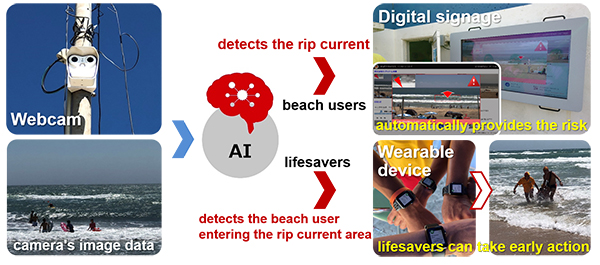
Figure 3. Conceptual diagram of accident prevention/early rescue and lifesaving system using AI and IoT: When AI detects a rip current, real-time visualized alert is displayed on the digital signage at the beach to warn the beach users. Furthermore, when there is a person entering the rip current area, a request for rescue is sent to the lifesavers' smartwatches.
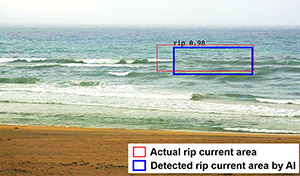
Figure 4. Verification example of rip current detection precision at the time of constructing AI engine: The area where a rip current is actually occurring and the rip current detection area by AI are matched almost completely.
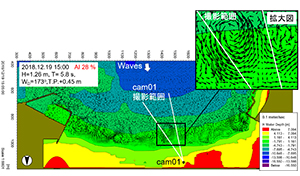
Figure 5. Example of verification results by nearshore current calculation: Occurrence of rip currents (offshore flow) can be confirmed within the camera's shooting range.
To a comprehensive accident prevention system to watch the beach
In order to achieve zero accidents on the beaches, it is better not to approach them. However, the excitement and learning gained through various beach activities will not only help children grow, but improve the quality of life of adults. Meanwhile, making the use of a life jacket obligatory, in addition to the spread of safety education and usage regulations of the area, may be a good option for preventing water accidents. Life jackets that ensure a certain level of buoyancy are surely effective as measures against drowning. Nonetheless, making it obligatory may lead to a lack of ability to sense danger and act with security in mind. In various seaside environments, the ability of users to manage risks by themselves including the need for life jackets is the essence of accident prevention, and the authors believe that advanced technology will help eliminate the risk perception bias among beach users. Currently, the authors are developing new technologies using AI and IoT, including alerting beach users to the offshore wind, which is the second cause of accidents following rip currents, automatic detection of people flowing offshore, and automatic detection of help signs (swinging motion with one hand).
References
- ^ Ishikawa, T., Komine, T., Aoki, S. and Okabe, T.: Characteristics of Rip Current Drowning on the Shores of Japan, Journal of Coastal Research, Special Issue 72, pp. 44-49, 2014.
- ^ Brighton, B., Sherker, S., Brander, R., Thompson, M. and Bradstreet, A.: Rip current related drowning deaths and rescues in Australia 2004-2011, Nat. Hazards Earth System Sciences, 13, pp.1069-1075, 2013.
- ^ Komine, T., Tanaka, H., Takyu, H., Kinoshi, T., Gotoh, S., Sone, E., Sagisaka, R., Ishikawa, T. and Shimazaki, S.: Effectiveness of surf lifesaver on OHCA occurred by drowning on the beaches in Japan. 8th Asian Conference for Emergency Medicine, 2015.
- ^ Ishikawa, T., Kazama, T., Nakagawa, Y., Aoki, S., Tanaka, S., Komine, T. and Nakayama, A.: Proposal of beach risk assessment method of Japan, Japan Society of Civil Engineers Collection of Academic Papers B3 (Ocean development), Vol. 72, No. 2, pp. I_826-I_831, 2016.
- ^ Endo S., Shimoida, H., Ishikawa, T. and Komine, T.: Improving risk management awareness of swimmers by visualization of rip current, Japan Society of Civil Engineers Collection of Academic Papers B3 (Ocean development), Vol. 75, No. 2, pp. I_679-I_684, 2019.
[*]Consortium by Chuo University, Konica Minolta Japan, Inc., Japan Lifesaving Association, and the Town of Onjuku. (FY 2018 IoT Service Creation Support Project by Ministry of Internal Affairs and Communications)
- Toshinori Ishikawa
Professor, Chuo University Research and Development Initiative
Area of Specialization: Coastal Engineering - Toshinori Ishikawa was born in Kanagawa Prefecture in 1973.
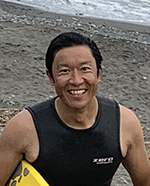
He graduated from the School of Marine Science and Technology, Tokai University in 1995, and completed the Master’s Program in the Graduate School of Marine Science and Technology of the same university in 1997. He holds a PhD in engineering, and a license as professional engineer (construction: rivers, sand control and coast/ocean).
He worked at Pacific Consultants Co., Ltd., Seashore Laboratory, Ltd., Nagisa Research Institute of the Public Works Research Center as Senior Researcher and Chuo University Faculty of Science and Engineering as part-time lecturer before assuming his current position in 2019.
He is currently assuming the positions of Director of Drowning Prevention, Rescue and Lifesaving Section at Japan Lifesaving Association, Rescue Commission Member at International Life Saving Federation, and Ocean Safety Promotion Advisor at Japan Coast Guard.
Area of specialization: Coastal engineering
His research themes include coastal maintenance, beach deformation, wave analysis, and rip current analysis. In recent years, he focuses on the development of technologies for risk management for coastal use, prevention of water accidents and rescue methods.








